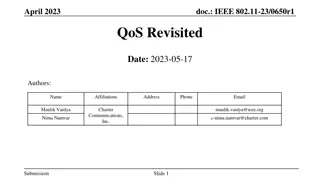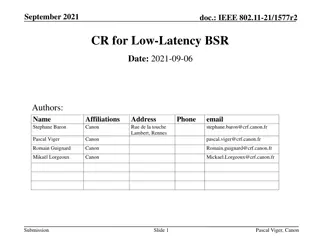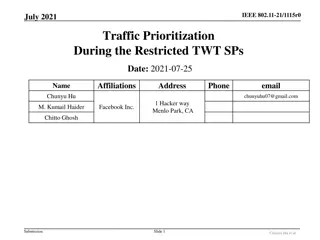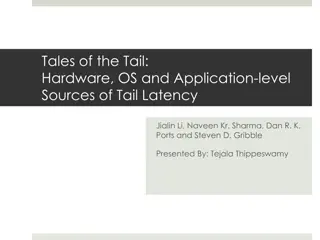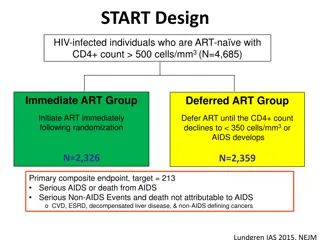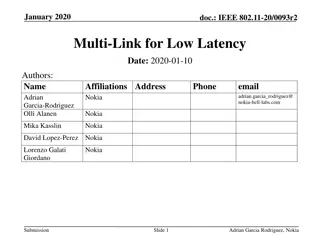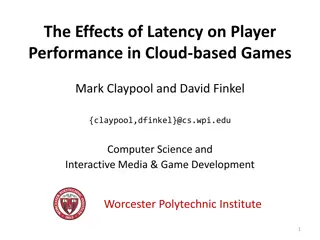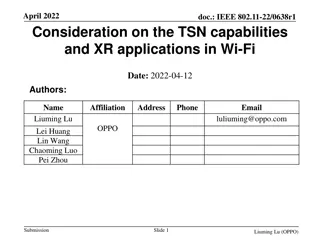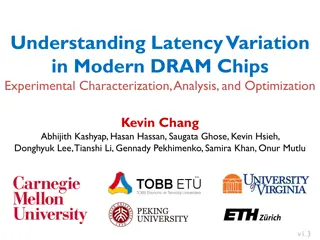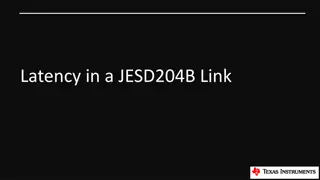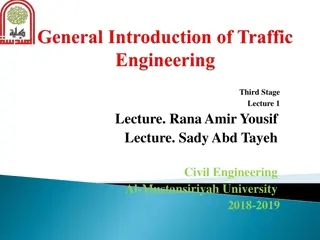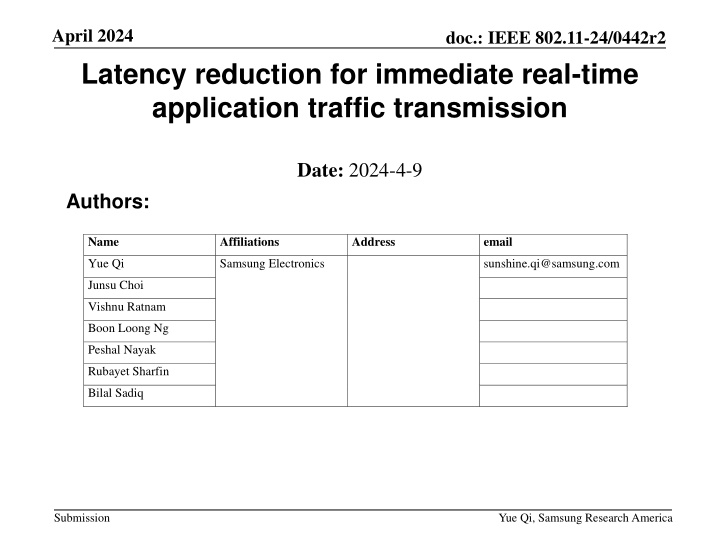
Latency Reduction for Real-Time Application Traffic Transmission
Explore the research on reducing latency for immediate real-time application traffic transmission in IEEE 802.11, aiming to improve customer experience and meet the demands of new applications like metaverse, robotics, and more. The study introduces methods like preemption within PPDU and TXOP to enhance low latency traffic, emphasizing the need for better communication for real-time applications.
Download Presentation

Please find below an Image/Link to download the presentation.
The content on the website is provided AS IS for your information and personal use only. It may not be sold, licensed, or shared on other websites without obtaining consent from the author. If you encounter any issues during the download, it is possible that the publisher has removed the file from their server.
You are allowed to download the files provided on this website for personal or commercial use, subject to the condition that they are used lawfully. All files are the property of their respective owners.
The content on the website is provided AS IS for your information and personal use only. It may not be sold, licensed, or shared on other websites without obtaining consent from the author.
E N D
Presentation Transcript
April 2024 Latency reduction for immediate real-time application traffic transmission doc.: IEEE 802.11-24/0442r2 Date: 2024-4-9 Authors: Name Affiliations Address email Yue Qi Samsung Electronics sunshine.qi@samsung.com Junsu Choi Vishnu Ratnam Boon Loong Ng Peshal Nayak Rubayet Sharfin Bilal Sadiq Submission Yue Qi, Samsung Research America
April 2024 doc.: IEEE 802.11-24/0442r2 Introduction The approved PAR intends to define at least one mode of operation capable of improving the tail of the latency distribution and jitter compared to Extremely High Throughput MAC/PHY operation. Reducing the low latency for the increasing demand of real-time application (RTA) is important in 11bn: The need for 11bn includes: more stringent requirements are needed to meet the demands of new applications (including metaverse, augmented and virtual reality, robotics, industrial automation for industrial IoT, logistics and smart agriculture) . Lower latency leading to better customer experience (especially worst case latency/jitter mattering). Low latency communication becoming essential building block for RTA. According to KPI and PAR discussions [1], some use cases, e.g., real-time gaming requires at least less than 5ms for latency and 2ms for jitter. Use cases Intra BSS latency [ms] Jitter variance [ms] Packet loss Data rate [Mbps] Real-time gaming < 5 < 2 < 0.1 % < 1 Cloud gaming < 10 < 2 Near-lossless < 0.1 (Reverse link) > 5Mbps (Forward link) Real-time video < 3 ~ 10 < 1~ 2.5 Near-lossless 100 ~ 28,000 Submission Yue Qi, Samsung Research America
April 2024 doc.: IEEE 802.11-24/0442r2 Background To improve the low latency (LL) traffic, preemption is considered: within a PPDU [2, 3]: In case of long PPDU transmission, a TXOP holder can transmit the LL frame by inserting it into the current PPDU. HDR Payload Payload Payload Payload HDR PPDU Payload HDR LS payload HDR PPDU Payload PPDU Payload PPDU Payload Fig. 1 inserting LL payload into current PPDU [2] within a TXOP [4-7]: In case of LL frame buffered at a non-TXOP holder, the low latency frame can be transmitted before finishing the current TXOP. within both time and frequency resource unit [8, 9]: a TXOP holder can transmit the LL frame on the ongoing PPDUs using 2D A-PPDU for DL and 2D RORA for UL. Fig. 3 2D A-PPDU [8] Fig. 2 preemption in a TXOP [5] Submission Yue Qi, Samsung Research America
April 2024 doc.: IEEE 802.11-24/0442r2 Abstract In this presentation, we introduce a dedicated RU for RTA traffics which can be piggybacked on ongoing regular traffics. This method can benefit for the RTA traffics in both UL and DL cases. Submission Yue Qi, Samsung Research America
April 2024 doc.: IEEE 802.11-24/0442r2 RTA transmission request Real time traffic enqueued Real time traffic transmitted PPDU transmission end PPDU transmission start Real time traffic enqueued PPDU Ongoing PPDU transmission Medium access by other devices and back-off time latency RTA traffics may suffer from unpredictable and large transmission latency. RTA may request for extremely low medium access latency, in which RTA traffics can be transmitted as soon as being enqueued. Submission Yue Qi, Samsung Research America
April 2024 doc.: IEEE 802.11-24/0442r2 Proposed solution New protocol for immediate transmission of RTA traffic Real time traffic enqueued Real time traffic transmitted PPDU transmission end PPDU transmission start Real time traffic enqueued PPDU Ongoing PPDU transmission Medium access by other devices + back-off time latency Real time traffic piggybacked on ongoing transmission Real time traffic enqueued PPDU transmission end PPDU transmission start Real time traffic enqueued PPDU Ongoing PPDU transmission latency time Real time Traffic transmitted Yue Qi, Samsung Research America Submission
April 2024 doc.: IEEE 802.11-24/0442r2 Proposed solution (cont d) RTA traffic allowed to be immediately piggybacked to ongoing transmission. The RTA traffics may come after the transmission begins. A dedicated new type of the RUs (specially reserved for latency sensitive transmission) spared for possible immediate transmission. STF, LTF, and reduced PHY header can be transmitted in the middle of transmission. To reserve the channel from being stolen by OBSS STAs, methods can be considered, e.g., reservation by AP/other non-LL STAs or via the help of MAP. Dedicated RUs reserved for possible Immediate transmission RUs assigned for regular transmission Frequency STF + LTF Time Regular transmission Real time traffics Submission Yue Qi, Samsung Research America
April 2024 doc.: IEEE 802.11-24/0442r2 Proposed solution (cont d) RUs assigned for regular transmission Before 11bn: Resource unit not belonging to anyone. Occupiable after frequency domain back-off. When the RTA traffics enqueue after transmission, it cannot transmit anymore. Transmission over RU should align with regular transmission. In this proposal: Newly introducing a special type of RU specially dedicated for latency sensitive traffics. Immediately occupiable and may not require back-off. When the RTA traffics enqueue after the current transmission, it may still take a chance to transmit. Transmission over new type of RUs possibly need not align with regular transmission. New type of RU can be available for both uplink and downlink. frequency STF + LTF Time Regular transmission RUs assigned for regular transmission dedicated RU frequency PHY header Time Real time traffics Regular transmission Submission Yue Qi, Samsung Research America
April 2024 doc.: IEEE 802.11-24/0442r2 References [1] Considerations on UHR PAR and KPIs, IEEE 802.11-22/1919 [2]11-21-0670-00-00be-further-improve-latency-performance-in11be [3]11-22-1880-01-0uhr-latency-and-reliability-enhancements-for-uhr [4]11-23-0018-01-0uhr-low-latency-support-in-uhr [5]11-23-1174-00-0uhr-txop-preemption-follow-up [6]11-23-0092-00-0uhr-preemption [7]11-23-1229-00-0uhr-preemption-for-low-latency-application-follow-up [8]11-23-1953-00-00bn-two-dimensional-resource-allocation (UL OFDMA) [9]11-23-1954-00-00bn-two-dimensional-a-ppdu (DL) Submission Yue Qi, Samsung Research America

